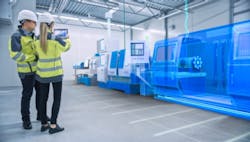How COVID-19 boosted augmented reality and virtual reality in manufacturing
By Ryan Condon, head of content at Comparesoft
Before 2020, the use of augmented reality (AR) and virtual reality (VR) technologies in business was steadily growing. AR and VR were listed as the top technologies consumers are seeking to assist them in their daily lives by a 2019 Neilsen global survey. There was a combined 94.3 million users in the US alone in 2018 and global spending on mixed reality technologies was forecasted to reach $160 billion by 2023, mainly in sectors like consumer, manufacturing, retail and healthcare.
But in March 2020, the world shut down. COVID-19 affected almost everything and everyone, from the way businesses operate to how we went about our daily lives. There was one area, however, that not only avoided being caught in the global downfall but that actively thrived—the adoption of augmented-reality and virtual-reality technologies.
More businesses explored the idea of using AR and VR tech in a socially distanced environment. This led to a dramatic increase in both forecasted global spending and AR/VR adoption rates. But how else has COVID-19 impacted the use of VR & AR in business?
Three industries to benefit from immersive-reality technology
Arts & entertainment: This was an industry that suffered from the drop in footfall traffic between 2020 and 2021. To combat that, museums opened up their doors to anyone with a VR headset. This enabled visitors to experience the British Museum or Paris’s Louvre in their own homes.
Healthcare: Social distancing protocols and a lack of staff hindered training for some healthcare professionals. But, thanks to mixed-reality tech, facilities were able to still provide the training required for nurses and doctors. Staff could use virtual reality training to immerse themselves in procedures such as neurosurgery.
Field services: AR and VR technologies allowed businesses to provide complete field assistance for their technicians and engineers. Field workers could immerse themselves in real-life scenarios, including infrastructure and machine repair, by combining immersive tech with IoT sensors and real-time data.
Risks still associated with AR & VR adoption
Before getting carried away with the idea of a mixed reality working world, remember that AR and VR pose risks similar to that of other technologies. These include online safety and security, data protection, and virtual harassment…to name a few.
But there is one risk that can negatively impact immersive reality adoption rates; available bandwidth. Without the right infrastructure, such as 5G access and large data collection capabilities, immersive technology will be limited. This could create an even greater technological poverty gap between those that have the infrastructure to use immersive tech and those that don’t.
How far can immersive technology go?
Augmented-reality and virtual-reality technologies play a significant role among manufacturers and will continue to do so for many years to come. Ultimately, three areas will enable the use of immersive tech in business to either succeed or fail—affordability, accessibility and bandwidth.
